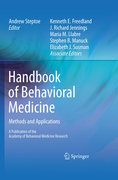
Many books about behavioral medicine techniques and applications published inthe past are now outdated, and do not reflect the diversity and excitement ofthe field in the new millennium. This Handbook aims to fill this gap by providing an up-to-date survey of methods and applications across the broad range of behavioral medicine research and practice. The chapters will be written by fellows of the Academy of Behavioral Medicine Research , a distinguished scientific society of active behavioral medicine researchers. This book will reflectan innovative structure based on cutting-edge methodologies and applications that are relevant across different medical conditions. The book will focus on established and emerging methods of investigation and their application in clinical and basic research settings. This will provide researchers and practitioners with practical advice on methods that can be used in their work, and insights into the scientific knowledge underpinning these applications. Avioral, psychosocial and biomedical science knowledge and techniques relevant to the understanding health and illness, and the application of this knowledge and these techniques to prevention, diagnoses, treatment and rehabilitation. Written by a diverse and respected panel of researchers representing the Academy of Behavioral Medicine Research. Surveys the current field of behavioral medicine research and applications using an innovative structure which captures cutting edge practices. INDICE: "Section 1 Behavioral processes and measures.- 1. Improving the quality of behavior reporting - Stone (Stony Brook)-m.- 2. Assessment of physical activity (objective, questionnaire, etc) - Blumenthal (Duke)-m.- 3. Dietary assessment in behavioral medicine -Wing (Brown)-m.- 4. Sexual behavior (assessment and patterns).- 5. Habit formation - Verplanken (Bath).- 6. Adherence to medical advice - Dunbar-Jacob (Pittsburgh)-m.- 7. Screening for cancer and other diseases - Wardle (London).- Section 2 Psychological processes and measures.- 8. Questionnaire and interview measures - Reise (UCLA).- 9. Ecological momentary assessment and other techniques (eg DRM) - Stone (Stony.- Brook)-m.- 10.The PROMIS (Patient-Reported Outcomes Measurement Information System).- initiative - Cella (Northwestern).- 11. Applications of cognitive testing in behavioral medicine - Waldstein (Baltimore)-m.- 12. Lay representations of health and illness - Leventhal (Rutgers)-m.- 13. Depression and negative affect in health and disease - Davidson (Columbia)-m.- 14. Hostility and health - Barefoot (Duke)-m.- 15. Positive affect and health - Cohen (Carnegie Mel1on)-m.- 16. Coping processes in health - Ironson (Miami)-m or Lutgendorf (Iowa)-m.- 17. Fatigue and medically unexplained symptoms - Natelson (UMDNJ)-m.- Section 3 Social and interpersonal processes.- 18. Experimental approaches to social interaction - Suls (Iowa)-m.- 19. Social support and health - Helgeson or Cohen (Pittsburgh)-m.- 20. Social networks and disease - House (Ann Arbor)-m.- 21. Social norms and behavior -.- 22. Social marketing -.- 23. Applications of new technologies (e.g. Internet) - Brug (Amsterdam) or Kreuter (St.- Louis).- Section 4 Epidemiological and population perspectives.- 24. Population-based study designsin behavioral medicine - Kaplan (Ann Arbor)-m.- 25. Socioeconomic status and health (etiology, disease management, access) - Matthews.- (Pittsburgh)-m.- 26. Ethnic and cultural issues -Williams (Harvard).- 27. Assessment of psychosocial factors in population studies - Powell (Rush)-m.- 28. Health literacy and engagement -.- 29. Sociocultural and biological determinants of obesity - Jeffrey (Minneapolis)-m.- 30. Impact of interventions on public health (e.g. Re-aim) - Glasgow (Denver).- Section 5 Genetic process in behavioral medicine.- (Associate Editor: Stephen B Manuck, Pittsburgh-m).- 3 1. Principles of genetic-sensitive designs (family, twin studies) - de Geus (Amsterdam).- 32. Methods ofidentifying genes relevant to behavioral medicine (SNPs, genornics,.- Mendelian randomization, gene x environment) - McCaffery (Brown).- 33. Genetics of personality and temperament, Cloninger (St Louis).- 34. Genetic factors relevantto health behaviors (smoking, physical activity, diet, sexual.- behavior) - Lerman (Philadelphia)-m.- 35. Genetics of stress exposure and stress responsivity - Williams (Duke)-m.- 36. Genetics of mood disorders - Kendler (Virginia).-37. Phenotyping of behavioral traits and disorders - Crawley (Chapel Hill) and.- Kaufmann (N1H)-m.- Section 6 Development and the lifecourse.- (Associate Editor: Edith Chen, Vancouver).- 38. Lifecourse study methodology.- 39. Perinatal processes - Coe (Madison)-m.- 40. Early adversity infleunces on health - Taylor (UCLA)-m.- 41. Health behavior in children and adolescents - Sallis (San Diego).- 42. Social status in adolescence - Chen (Vancouver).- 43. Reproductive functions (including menopause ) - Light (Chapel Hill)-m.- 44. Aging - Schulz (Pitttsburgh)-m.- Section 7 Biological measures and biomarkers.- 45. Use of biological measures in behavioral medicine (laboratory, clinical and.- naturalistic settings, etiological and treatment studies) - Steptoe (London)-m.- 46. Stress and allostasis - McEwen (Rockefeller)-m.- 47. Laboratory stress testingmethodology - Gerin (Columbia)-m.- 48. Neuroendocrine measures - Hellhammer (Trier)-m.- 49. Immune measures - Glaser & Kiecolt-Glaser (Columbus)-m.- 50. Inflammatory and coagulation markers - Mills (San Diego)-m.- 51. Assessment of autonomic activity (SNS, heart rate variablity) - Thayer (Ohio)-m.- 52. Blood pressure and hemodynamics - Pickering (Columbia)-m.- 53. Cardiac measures -Sheps (Gainesvil1e)-m.- Authors to consider applications to clinical issues including cardiovascular disease.- infection and HIV, cancer, fatigue, pain, wound healing, autoimmune disease, where.- appropriate.- Section 8 Brain function and neuroimaging.- (Associate Editor: Richard Jennings, Pittsburgh-m).- 54. Neuroimaging methods in behavioral medicine - Critchley (Brighton).- 55. Electrophysiological methods in behavioral medicine - Jennings (Pittsburgh)-m.- 56.Stress reactivity - Gianaros (Pittsburgh).- 57. Serotonergic pathways - Manuck (Pittburgh)-m.- 58. Depression and other emotional states - Dolan (London).-Section 9 Statistical methods.- (Associate Editor: Maria Llabre, Miami-m).- 59. Mediation and effect modification - Kraemer (Stanford).- 60. Multi-level modeling - Schwartz (Stony Brook)-m.- 61. Structural equation modeling - Llabre (Miami)-m.- 62. Survival and growth curve analysis.- 63. Meta-analysis - Suls (Iowa)-m.- 64. Reporting of results (effect sizes, etc) - Babyak (Duke)-m.- Section 10 Behavioral and psychosocial interventions.- (Associate Editor: Kenneth Freedland, St Louis-m).- 65. Principles of clinical trials - Kaufman (N1H)-m.- 66. Trial design (control groups, etc) - Freedland (St Louis)-m.- 67. Quality of life assessments - Czajkowski (Chapel Hill)-m.- 68. Lifestyle interventions for primary and secondary prevention - Oldenburg.- (Melbourne).- 69. Biofeedback and other behavioral treatments for physical disorders.- 70. Psychosocial interventions in the treatment of disease processes and physical.- impairment - Schneiderman (Miami)-m.- 7 1. Integrating evidence-based clinical and community strategies - Ocltene (Worcester)."
- ISBN: 978-0-387-09487-8
- Editorial: Springer
- Encuadernacion: Cartoné
- Páginas: 1080
- Fecha Publicación: 29/10/2010
- Nº Volúmenes: 1
- Idioma: Inglés
